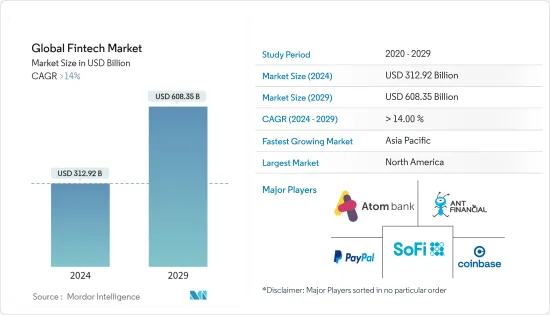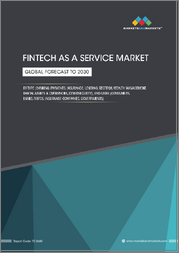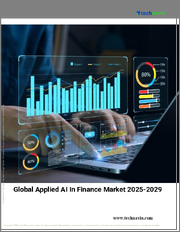
|
시장보고서
상품코드
1524193
세계의 핀테크(FinTech) 시장 : 시장 점유율 분석, 산업 동향 및 통계, 성장 예측(2024-2029년)Global Fintech - Market Share Analysis, Industry Trends & Statistics, Growth Forecasts (2024 - 2029) |
||||||
세계의 핀테크(FinTech) 시장 규모는 2024년에 3,129억 2,000만 달러로 추정되고, 2029년에는 6,083억 5,000만 달러에 이를 것으로 예측되며, 예측기간 중(2024-2029년) CAGR은 14% 이상으로 성장할 것으로 예측됩니다.

금융 산업에서 FinTech는 금융 기술의 약자입니다. 자동화되고 강화된 금융 서비스를 제공하는 비즈니스에서 FinTech는 컴퓨터 프로그램 및 기타 현대 기술을 가리킵니다. FinTech 분야는 시간이 지남에 따라 크게 발전하여 기업이 고객 지향을 강화하고 있습니다. 따라서 신흥 기업부터 하이테크 기업, 전통 기업까지 전 세계에 존재하는 수많은 비즈니스 중에서 포지션을 찾기가 어렵습니다. FinTech와 금융 서비스 기관은 끊임없이 변화하는 비즈니스 상황에서 창조적 파괴의 새로운 아이디어를 추구하고 협력적 또는 경쟁적인 태도로 서로의 차선을 서로 빼앗아 왔습니다.
FinTech 업계 성장의 원동력이 된 것은 몇 번의 위기였습니다. 지난 세계 금융 위기 이후 FinTech에 대한 투자는 증가의 길을 따라가고 있습니다. 전통적인 금융서비스 부문은 위기 도중에도 엄격하게 압박되어 그 약점이 기술적인 반동이 되어 이 부문의 확대로 이어졌습니다. 마찬가지로 COVID-19 팬데믹도 세계경제에 비참한 영향을 주어 불황의 시작이 되었습니다. 이 위기의 결과로 FinTech 산업은 더욱 빠르게 발전했습니다. 주요 금융기관은 팬데믹에 대응하고 새로운 시장에 대한 액세스를 얻기 위해 신진 기예 기술 기업과 협력했습니다. FinTech 비즈니스는 기업 자체가 고객층과 제공 서비스의 폭을 넓히기 위해 주요 은행과의 제휴를 모색하고 있음에도 불구하고 성장을 계속하고 있습니다.
최근 몇 년동안 InsurTech, RegTech, 지불 서비스 등 특정 산업 및 역할에 맞게 맞춤형 최첨단 기술을 채택한 FinTech 하위 유형이 등장했습니다. FinTech 분야가 단순한 유행에 그치지 않는 지금, 조직의 계획 달성 정도는 더욱 중요해지고 있습니다. FinTech 비즈니스는 기술적 측면에서 빠르게 성장하고 있습니다. 블록체인, 프로세스 자동화, 용도 프로그래밍 인터페이스(API), 로봇, 데이터 분석 등 정확성, 효율성, 민첩성을 높이는 기술의 채용이 증가하고 있습니다.
FinTech 시장 동향
디지털 결제 급증으로 시장 견인
송금과 결제는 FinTech 업계에서 기본적인 역할을 하며 금융서비스 혁신과 디지털 전환의 초석이 되고 있습니다. 송금 및 결제는 비은행 및 저은행 인구 등 충분한 서비스를 받지 않은 사람들의 금융 서비스에 대한 액세스를 용이하게 합니다. 송금 및 결제에서 FinTech의 혁신은 편리하고 효율적이며 사용자 친화적인 결제 솔루션을 제공하여 전반적인 고객 경험을 향상시킵니다.
디지털 결제는 송금 및 금융 거래를 보다 빠르고 효율적이고 안전하게 수행할 수 있는 방법을 제공함으로써 FinTech 업계에 혁명을 가져왔습니다. 최근 스마트폰, 인터넷, 기타 디지털 기술의 보급으로 디지털 결제의 이용이 확대되고 있습니다. 디지털 결제는 많은 FinTech 혁신의 기반이 되었습니다. FinTech 기업은 디지털 결제 인프라를 활용하여 피어 투 피어(P2P) 송금, 온라인 대출, 로보 어드바이저, 보험 등 다양한 서비스를 제공합니다. 이러한 솔루션은 디지털 결제 채널을 활용하여 금융 접근성과 인클루전을 향상시킵니다. 디지털 결제를 이용하면 고객은 시간이나 장소에 관계없이 현물 통화나 카드 없이 거래를 할 수 있습니다. 이러한 편의성으로 인해 디지털 결제 이용이 크게 증가하고 있습니다.
FinTech 주도의 디지털 결제는 특히 국경을 넘은 거래의 경우, 종래의 은행 거래에 비해 거래 수수료가 낮게 억제되는 경우가 많습니다. 이 비용 효율성은 소비자와 기업 모두에게 이점을 제공하고 거래와 관련된 경제적 장벽을 줄이고 FinTech 결제 솔루션의 도입을 촉진합니다. FinTech 기업은 견고한 암호화, 생체 인증 및 사기 감지 메커니즘을 도입하여 디지털 결제 보안을 우선시합니다. 이러한 대책은 금융거래의 안전성을 높이고, 이용자에게 신뢰를 주고, 디지털 결제 솔루션의 폭넓은 채용을 촉구하고 있습니다.
아시아태평양은 디지털화의 진전과 지원 규제 프레임 워크를 통해 시장을 선도
아시아태평양은 몇 가지 중요한 요인으로 FinTech 시장의 견조한 성장과 수요 증가를 경험하고 있습니다. 첫째, 인터넷과 스마트폰의 보급에 힘입어 디지털 경제가 급속히 확대되고 있는 것이 FinTech의 혁신과 도입을 위한 비옥한 토양을 창출하고 있습니다. 디지털에 익숙한 소비자가 많아 디지털 채널을 통해 제공되는 편리하고 이용하기 쉬운 금융 서비스에 대한 수요가 높아지고 있습니다.
게다가 디지털화와 금융포섭 촉진을 목적으로 한 정부의 이니셔티브가 지원적인 규제 프레임워크과 함께 이 지역에서 FinTech의 성장을 가속하는 환경을 조성하고 있습니다. 중국, 인도, 싱가포르, 호주와 같은 국가들이 FinTech의 허브로 부상하고 있으며 많은 투자와 인재를 끌어들이고 있습니다. 일부 정부의 이니셔티브와 규제 체제는 아시아태평양에서 FinTech의 성장을 지원합니다. 예를 들어, RBI는 다른 은행 간의 원활한 실시간 결제를 가능하게 하고 디지털 거래를 촉진하는 통합 결제 인터페이스(UPI)와 같은 인도에서 FinTech의 성장을 가속하기 위한 몇 가지 조치를 도입하고 있습니다. 마찬가지로 FinTech 기업은 싱가포르 금융관리국(MAS)이 설립한 규제 샌드박스 프로그램을 활용하여 안전한 환경에서 새로운 상품과 서비스를 테스트할 수 있습니다. 디지털 지갑, 결제 처리, 암호화폐 서비스 등 다양한 결제 활동에 대한 규제 프레임워크를 제공하는 결제 서비스법도 MAS에서 채택하고 있습니다.
아시아태평양은 FinTech의 혁신과 투자의 중심지로서의 역할을 계속하고 있으며, FinTech가 전통적인 금융서비스를 파괴하고 산업정세를 변화시키는 가운데 업계의 장기적인 성장과 변혁을 추진하기 좋은 위치에 있습니다.
FinTech 업계 개요
FinTech 시장은 역동적으로 진화하고 있으며, 지속적인 기술 혁신, 소비자 선호 변화, 규제 개발, 다양한 산업 기업 간의 전략적 제휴가 그 원동력이 되고 있습니다. 이 시장의 주요 기업으로는 Ant Financials, Atom Bank, SoFi, Paypal, Coinbase 등이 있습니다.
기타 혜택 :
- 엑셀 형식 시장 예측(ME) 시트
- 3개월간의 애널리스트 서포트
목차
제1장 서론
- 조사의 전제조건 및 시장 정의
- 조사 범위
제2장 조사 방법
제3장 주요 요약
제4장 시장 인사이트 및 역학
- 시장 개요
- 시장 성장 촉진요인
- 디지털 결제의 상승
- FinTech 기업에 대한 투자 증가
- 시장 성장 억제요인
- 격렬한 경쟁
- 사이버 보안 위험 증가
- 시장 기회
- 진화하는 블록체인 기술 및 암호화폐
- 종래의 금융기관과의 제휴
- 밸류체인 분석
- 업계의 매력도-Porter's Five Forces 분석
- 신규 진입업자의 위협
- 구매자 및 소비자의 협상력
- 공급기업의 협상력
- 대체품의 위협
- 경쟁 기업간 경쟁 관계
- 시장에서의 혁신의 인사이트
- 시장에 대한 COVID-19의 영향
제5장 시장 세분화
- 서비스 프로포지션별
- 송금 및 결제
- 저축 및 투자
- 디지털 대출 및 대출 마켓플레이스
- 온라인 보험 및 보험 마켓플레이스
- 기타 서비스 프로포지션
- 지역별
- 북미
- 미국
- 캐나다
- 기타 북미
- 유럽
- 영국
- 독일
- 프랑스
- 스페인
- 기타 유럽
- 라틴아메리카
- 브라질
- 아르헨티나
- 멕시코
- 기타 라틴아메리카
- 아시아태평양
- 중국
- 인도
- 일본
- 한국
- 기타 아시아태평양
- 중동 및 아프리카
- 아랍에미리트(UAE)
- 사우디아라비아
- 기타 중동 및 아프리카
- 북미
제6장 경쟁 구도
- 시장 집중도 개요
- 기업 프로파일
- Ant Financials
- Zhong An International
- Atom Bank
- Paypal
- SoFi
- CoinBase
- Robinhood
- Adyen
- N 26
- Ally Financials
- Oscar Health
- Klarna
- Avant*
제7장 시장 동향
제8장 면책사항 및 회사소개
AJY 24.08.13The Global Fintech Market size is estimated at USD 312.92 billion in 2024, and is expected to reach USD 608.35 billion by 2029, growing at a CAGR of greater than 14% during the forecast period (2024-2029).

In the financial industry, fintech stands for financial technology. In businesses that offer automated and enhanced financial services, fintech refers to computer programs and other contemporary technologies. The fintech sector has developed significantly over time, which has caused businesses to become more customer-focused. It is, therefore, difficult to find a position among the many businesses that exist worldwide, which range from startups to tech enterprises to well-established businesses. Fintech and financial service organizations have pursued disruptive and new ideas in an ever-changing business landscape, taking up each other's lanes with either a collaborative or a competing attitude.
Multiple crises have served as a driving force behind the growth of the fintech industry. Fintech investments have been rising since the last global financial crisis. The traditional financial services sector was severely pressed both during and after the crisis, and its weaknesses led to a technological reaction that resulted in the sector's expansion. In a similar vein, the COVID-19 pandemic also had a disastrous effect on the world economy and started the recession. The fintech industry developed more quickly as a result of this crisis. Large financial institutions collaborated with up-and-coming tech firms in response to the pandemic in order to gain access to the new market. The fintech business is growing even though the companies themselves are looking to collaborate with big banks to broaden their clientele and offerings.
In recent years, numerous fintech subtypes, such as insurtech, regtech, payment services, and others, have emerged that employ cutting-edge technologies customized for certain industries or roles. The degree of execution attained in an organization's plan is becoming more significant now that the fintech sector is more than just a fad. The fintech business is experiencing fast growth in its technological side. There has been an increased adoption of technology that allows for better accuracy, efficiency, and agility, such as blockchain, process automation, application programming interface (API), robotic and data analytics.
Fintech Market Trends
Surging Adoption of Digital Payments is Driving the Market
Money transfers and payments play a fundamental role in the fintech industry, serving as a cornerstone for financial services innovation and digital transformation. Money transfers and payments facilitate access to financial services for underserved populations, including the unbanked and underbanked. Fintech innovations in money transfers and payments improve the overall customer experience by offering convenient, efficient, and user-friendly payment solutions.
Digital payments have revolutionized the fintech industry by providing faster, more efficient, and more secure ways to transfer money and make financial transactions. The use of digital payments has grown in recent years due to the increasing adoption of smartphones, the Internet, and other digital technologies. Digital payments serve as the foundation upon which many fintech innovations are built. Fintech companies leverage digital payment infrastructure to offer different services, including peer-to-peer (P2P) transfers, online lending, robo-advisory, insurance, and more. These solutions enhance financial accessibility and inclusion by leveraging digital payment channels. With digital payments, customers can make transactions irrespective of the time and place without the need for physical currency or cards. This convenience has led to a significant increase in the use of digital payments.
Fintech-driven digital payments often have lower transaction fees when compared to traditional banking methods, especially for cross-border transactions. This cost efficiency benefits both consumers and businesses, reducing the financial barriers associated with conducting transactions and driving the adoption of fintech payment solutions. Fintech companies prioritize security in digital payments by implementing robust encryption, biometric authentication, and fraud detection mechanisms. These measures enhance the security of financial transactions, instilling trust in users and encouraging wider adoption of digital payment solutions.
Asia-Pacific Leading the Market Owing to Growing Digitalization Coupled with Supportive Regulatory Frameworks
Asia-Pacific is experiencing robust growth and rising demand in the fintech market, driven by several key factors. Firstly, the region's rapidly expanding digital economy, fueled by increasing Internet and smartphone penetration, is creating a fertile ground for fintech innovation and adoption. With a large population of digitally savvy consumers, there is a growing demand for convenient and accessible financial services delivered through digital channels.
Additionally, government initiatives aimed at promoting digitalization and financial inclusion, coupled with supportive regulatory frameworks, are fostering a conducive environment for fintech growth in the region. Countries like China, India, Singapore, and Australia are emerging as fintech hubs, attracting significant investment and talent. Several government initiatives and regulatory frameworks have supported the growth of fintech in Asia-Pacific. For instance, the RBI has introduced several measures to promote fintech growth in India, such as the Unified Payments Interface (UPI), which enables seamless real-time payments between different banks and promotes digital transactions. Similarly, fintech companies can test new goods and services in a safe setting by utilizing the regulatory sandbox program established by the Monetary Authority of Singapore (MAS). The Payment Services Act, which offers a regulatory framework for a range of payment activities such as digital wallets, payment processing, and cryptocurrency services, has also been adopted by MAS.
Asia-Pacific is well-positioned to continue serving as a center for fintech innovation and investment, propelling the industry's long-term growth and transformation as fintech disrupts traditional financial services and changes the industry landscape.
Fintech Industry Overview
The fintech market is dynamic and evolving, driven by ongoing technological innovation, changing consumer preferences, regulatory developments, and strategic partnerships among various industry players. The major players in the market include Ant Financials, Atom Bank, SoFi, Paypal, and Coinbase.
Additional Benefits:
- The market estimate (ME) sheet in Excel format
- 3 months of analyst support
TABLE OF CONTENTS
1 INTRODUCTION
- 1.1 Study Assumptions and Market Definition
- 1.2 Scope of the Study
2 RESEARCH METHODOLOGY
3 EXECUTIVE SUMMARY
4 MARKET INSIGHTS AND DYNAMICS
- 4.1 Market Overview
- 4.2 Market Drivers
- 4.2.1 Rise of Digital Payments
- 4.2.2 Rising Investments in FinTech Firms
- 4.3 Market Restraints
- 4.3.1 Intense Competition
- 4.3.2 Increasing Cybersecurity Risks
- 4.4 Market Opportunites
- 4.4.1 Evolving Blockchain Technology and Cryptocurrency
- 4.4.2 Collaboration with Traditional Financial Institutions
- 4.5 Value Chain Analysis
- 4.6 Industry Attractiveness - Porter's Five Forces Analysis
- 4.6.1 Threat of New Entrants
- 4.6.2 Bargaining Power of Buyers/Consumers
- 4.6.3 Bargaining Power of Suppliers
- 4.6.4 Threat of Substitute Products
- 4.6.5 Intensity of Competitive Rivalry
- 4.7 Insights into Technological Innovations in the Market
- 4.8 Impact of COVID-19 on the Market
5 MARKET SEGMENTATION
- 5.1 By Service Proposition
- 5.1.1 Money Transfer and Payments
- 5.1.2 Savings and Investments
- 5.1.3 Digital Lending and Lending Marketplaces
- 5.1.4 Online Insurance and Insurance Marketplaces
- 5.1.5 Other Service Propositions
- 5.2 By Geography
- 5.2.1 North America
- 5.2.1.1 United States
- 5.2.1.2 Canada
- 5.2.1.3 Rest of North America
- 5.2.2 Europe
- 5.2.2.1 United Kingdom
- 5.2.2.2 Germany
- 5.2.2.3 France
- 5.2.2.4 Spain
- 5.2.2.5 Rest of Europe
- 5.2.3 Latin America
- 5.2.3.1 Brazil
- 5.2.3.2 Argentina
- 5.2.3.3 Mexico
- 5.2.3.4 Rest of Latin America
- 5.2.4 Asia-Pacific
- 5.2.4.1 China
- 5.2.4.2 India
- 5.2.4.3 Japan
- 5.2.4.4 South Korea
- 5.2.4.5 Rest of Asia-Pacific
- 5.2.5 Middle East and Africa
- 5.2.5.1 United Arab Emirates
- 5.2.5.2 Saudi Arabia
- 5.2.5.3 Rest of Middle East and Africa
- 5.2.1 North America
6 COMPETITIVE LANDSCAPE
- 6.1 Market Concentration Overview
- 6.2 Company Profiles
- 6.2.1 Ant Financials
- 6.2.2 Zhong An International
- 6.2.3 Atom Bank
- 6.2.4 Paypal
- 6.2.5 SoFi
- 6.2.6 CoinBase
- 6.2.7 Robinhood
- 6.2.8 Adyen
- 6.2.9 N 26
- 6.2.10 Ally Financials
- 6.2.11 Oscar Health
- 6.2.12 Klarna
- 6.2.13 Avant*



















